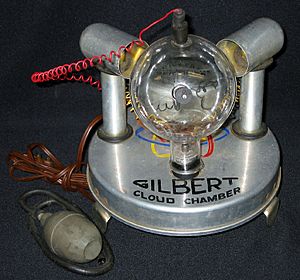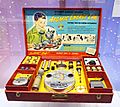Gilbert U-238 Atomic Energy Laboratory facts for kids
The Gilbert U-238 Atomic Energy Lab was a toy lab set that was produced by Alfred Carlton Gilbert, who was an American athlete, magician, toy-maker, business man, and inventor of the well-known Erector Set. The Atomic Energy Lab was released by the A. C. Gilbert Company in 1950. The kit's intention was to allow children to create and watch nuclear and chemical reactions using radioactive material.
Description
The lab contained a cloud chamber allowing the viewer to watch alpha particles traveling at 12,000 miles per second (19,000,000 m/s), a spinthariscope showing the results of radioactive disintegration on a fluorescent screen, and an electroscope measuring the radioactivity of different substances in the set.
Gilbert's original promotions claimed that none of the materials could prove dangerous. The instructions encouraged laboratory cleanliness by cautioning users not to break the seals on three of the ore sample jars, for "they tend to flake and crumble and you would run the risk of having radioactive ore spread out in your laboratory. This will raise the level of the background count", thus impairing the results of experiments by distorting the performance of the Geiger counter.
The Gilbert catalog copy included the reassurance that "All radioactive materials included with the Atomic Energy Lab have been certified as completely safe by Oak-Ridge Laboratories, part of the Atomic Energy Commission."
The set originally sold for $49.50 (equivalent to $600 in 2022 ) and contained the following:
- Battery-powered Geiger–Müller counter
- Electroscope
- Spinthariscope
- Wilson cloud chamber with short-lived alpha source (Po-210) in the form of a wire
- Four glass jars containing natural uranium-bearing (U-238) ore samples (autunite, torbernite, uraninite, and carnotite from the "Colorado plateau region")
- Low-level radiation sources:
- "Nuclear spheres" for making a model of an alpha particle
- Gilbert Atomic Energy Manual — a 60-page instruction book written by Dr. Ralph E. Lapp
- Learn How Dagwood Split the Atom — comic book introduction to radioactivity, written with the help of General Leslie Groves (director of the Manhattan Project) and John R. Dunning (a physicist who verified fission of the uranium atom)
- Prospecting for Uranium — a 1949 book published jointly by the Atomic Energy Commission and the United States Geological Survey
- Three C batteries
- 1951 Gilbert Toys catalog
A product catalog described the set as follows: "Produces awe-inspiring sights! Enables you to actually SEE the paths of electrons and alpha particles traveling at speeds of more than 10,000 miles per SECOND! Electrons racing at fantastic velocities produce delicate, intricate paths of electrical condensation – beautiful to watch. Viewing Cloud Chamber action is closest man has come to watching the Atom! Assembly kit (Chamber can be put together in a few minutes) includes Dri-Electric Power Pack, Deionizer, Compression Bulb, Glass Viewing Chamber, Tubings, Power Leads, Stand, and Legs."
Among other activities, the kit suggested "playing hide and seek with the gamma ray source", challenging players to use the Geiger counter to locate a radioactive sample hidden in a room.
Legacy
Unlike other A.C. Gilbert Company chemistry sets, the Atomic Energy Lab was never popular and was soon taken off the shelves. Fewer than 5000 kits were sold, and the product was only offered in 1950 and 1951. Gilbert believed the Atomic Energy Lab was commercially unsuccessful because the lab was more appropriate for those who had some educational background rather than the younger crowd that the A.C. Gilbert Company aimed for. Columbia University purchased five of these sets for their physics lab.
Images for kids




